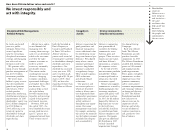Allstate 2005 Annual Report Download - page 21
Download and view the complete annual report
Please find page 21 of the 2005 Allstate annual report below. You can navigate through the pages in the report by either clicking on the pages listed below, or by using the keyword search tool below to find specific information within the annual report.
17
Book value per diluted share
As of December 31, ($ in millions, except per share data) 2004 2005
Book value per diluted share
Numerator: Shareholders’ equity $21,823 $20,186
Denominator: Shares outstanding and dilutive potential shares outstanding 688.0 651.0
Book value per diluted share $ 31.72 $ 31.01
Book value per diluted share, excluding the net impact of unrealized
net capital gains on fixed income securities
Numerator: Shareholders’ equity $21,823 $20,186
Unrealized net capital gains on fixed income securities 2,134 1,255
Adjusted shareholders’ equity $19,689 $18,931
Denominator: Shares outstanding and dilutive potential shares outstanding 688.0 651.0
Book value per diluted share, excluding the net impact of
unrealized net capital gains on fixed income securities $ 28.62 $ 29.08
We believe that investors’ understanding of
Allstate’s performance is enhanced by our disclosure
of the following non-GAAP and operating financial
measures. Our methods of calculating these meas-
ures may differ from those used by other companies
and therefore comparability may be limited.
Operating income is income before cumulative
effect of change in accounting principle, after-tax,
excluding:
• realized capital gains and losses, after-tax, except
for periodic settlements and accruals on non-
hedge derivative instruments which are reported
with realized capital gains and losses but includ-
ed in operating income,
• amortization of deferred policy acquisition costs
(“DAC”) and deferred sales inducements (“DSI”),
to the extent they resulted from the recognition
of certain realized capital gains and losses,
• (loss) gain on disposition of operations, after-tax,
and
• adjustments for other significant non-recurring,
infrequent or unusual items, when a) the nature
of the charge or gain is such that it is reasonably
unlikely to recur within two years, or (b) there
has been no similar charge or gain within the
prior two years.
Net income is the GAAP measure that is most
directly comparable to operating income.
We use operating income to evaluate our results
of operations. It reveals trends in our insurance and
financial services business that may be obscured by
the net effect of realized capital gains and losses,
(loss) gain on disposition of operations and adjust-
ments for other significant non-recurring, infre-
quent or unusual items. Realized capital gains and
losses and (loss) gain on disposition of operations
may vary significantly between periods and are gen-
erally driven by business decisions and economic
developments such as market conditions, the tim-
ing of which is unrelated to the insurance under-
writing process. Moreover, we reclassify periodic
settlements on non-hedge derivative instruments
into operating income to report them in a manner
consistent with the economically hedged invest-
ments, replicated assets or product attributes (e.g.
net investment income and interest credited to con-
tractholder funds) and by doing so, appropriately
reflect trends in product performance. Non-recur-
ring items are excluded because, by their nature,
they are not indicative of our business or economic
trends. Therefore, we believe it is useful for
investors to evaluate these components separately
and in the aggregate when reviewing our perform-
ance. We note that the price to earnings multiple
commonly used by insurance investors as a forward-
looking valuation technique uses operating income
as the denominator. We use adjusted measures of
operating income and operating income per diluted
share in incentive compensation. Operating income
should not be considered as a substitute for net
income and does not reflect the overall profitability
of our business.
The following tables reconcile operating income
and net income for the years ended December 31.
Operating income
Allstate Financial Consolidated Per diluted share
($ in millions, except per share data) 2004 2005 2001 2002 2003 2004 2005 2001 2002 2003 2004 2005
Operating income $ 551 $ 581 $
1,492
$
2,075
$
2,662
$
3,091
$
1,582
$ 2.06 $ 2.92 $ 3.77 $ 4.41 $ 2.37
Realized capital gains and losses 1 19 (352) (924) 196 591 549
Income tax (expense) benefit (4) (7) 127 326 (62) (199) (189)
Realized capital gains and losses, after-tax (3) 12 (225) (598) 134 392 360 (0.31) (0.84) 0.19 0.56 0.54
Reclassification of periodic settlements and accruals on non-hedge derivative
instruments, after-tax (32) (40) (4) (3) (15) (32) (40) (0.01) (0.01) (0.02) (0.04) (0.06)
DAC and DSI amortization related to realized capital gains and losses, after-tax (89) (103) (11) (1) (30) (89) (103) (0.01) — (0.05) (0.13) (0.16)
(Loss) gain on disposition of operations, after-tax (6) (12) (40) 2 (26) (6) (12) (0.06) — (0.04) (0.01) (0.02)
Non-recurring increase in liability for future benefits, after-tax — (22) ————(22) ————(0.03)
Income before dividends on preferred securities and cumulative effect of change
in accounting principle, after-tax 421 416 1,212 1,475 2,725 3,356 1,765 1.67 2.07 3.85 4.79 2.64
Dividends on preferred securities of subsidiary trust, after tax — — (45) (10) (5) — — (0.06) (0.01) — — —
Cumulative effect of change in accounting principle, after-tax (175) — (9) (331) (15) (175) — (0.01) (0.46) (0.02) (0.25) —
Net income $ 246 $ 416 $1,158 $1,134 $2,705 $3,181 $1,765 $ 1.60 $ 1.60 $ 3.83 $ 4.54 $ 2.64
Premiums and deposits is an operat-
ing measure that we use to analyze pro-
duction trends for Allstate Financial
sales. It includes premiums on insurance
policies and annuities and all deposits
and other funds received from customers
on deposit-type products including the
net new deposits of Allstate Bank, which
we account for under GAAP as increases
to liabilities rather than as revenue.
The following table illustrates where
premiums and deposits are reflected in
the consolidated financial statements for
the years ended December 31.
Premiums and deposits
($ in millions) 2001 2002 2003 2004 2005
Life and annuity premiums $ 1,345 $ 1,371 $ 1,365 $ 1,045 $ 918
Deposits to contractholder funds 7,970 9,484 10,373 13,616 12,004
Deposits to separate accounts and other 1,290 979 1,357 1,258 1,473
Total premiums and deposits $10,605 $11,834 $13,095 $15,919 $14,395
Book value per diluted share
excluding the net impact of unre-
alized net capital gains on fixed
income securities is calculated by
dividing shareholders’ equity after
excluding the net impact of unrealized
net capital gains on fixed income securi-
ties and related DAC and life insurance
reserves by total shares outstanding plus
dilutive potential shares outstanding.
Book value per diluted share is the most
directly comparable GAAP measure.
We use the trend in book value per
diluted share excluding unrealized net
capital gains on fixed income securities
in conjunction with book value per
diluted share to identify and analyze the
change in net worth attributable to
management efforts between periods.
We believe the non-GAAP ratio is use-
ful to investors because it eliminates the
effect of items that can fluctuate signifi-
cantly from period to period and are
generally driven by economic develop-
ments, primarily market conditions, the
magnitude and timing of which are
generally not influenced by manage-
ment, and we believe it enhances under-
standing and comparability of perform-
ance by highlighting underlying
business activity and profitability driv-
ers. We note that book value per dilut-
ed share excluding unrealized net capi-
tal gains on fixed income securities is a
measure commonly used by insurance
investors as a valuation technique. Book
value per diluted share excluding unre-
alized net capital gains on fixed income
securities should not be considered as a
substitute for book value per diluted
share and does not reflect the recorded
net worth of our business. The follow-
ing table shows the reconciliation.
New sales of financial products by
Allstate exclusive agencies is an
operating measure that we use to quan-
tify the current year sales of financial
products by the Allstate Agency propri-
etary distribution channel. New sales of
financial products by Allstate exclusive
agencies includes annual premiums on
new insurance policies, initial premi-
ums and deposits on annuities, net new
deposits in the Allstate Bank and sales
of other companies’ mutual funds, and
excludes renewal premiums. New sales
of financial products by Allstate exclu-
sive agencies for the years ended
December 31, 2005, 2004, 2003, 2002,
2001 and 2000 totaled $2.40 billion,
$2.27 billion, $1.83 billion, $1.61 bil-
lion, $702 million and $414 million,
respectively.
Combined ratio, excluding the
effect of catastrophe losses, is com-
puted as the difference between two
operating ratios, combined ratio (a
GAAP measure) and the effect of catas-
trophes on the combined ratio. The
most directly comparable GAAP meas-
ure is the combined ratio. We believe
that this ratio is useful to investors and
it is used by management to reveal the
trends in our property-liability business
that may be obscured by catastrophe
losses, which cause our loss trends to
vary significantly between periods as a
result of their rate of occurrence and
magnitude. We believe it is useful for
investors to evaluate these components
separately and in the aggregate when
reviewing our underwriting perform-
ance. The combined ratio excluding
the effect of catastrophe losses should
not be considered a substitute for the
combined ratio and does not reflect the
overall underwriting profitability of our
business. The following table shows the
reconciliation for the years ended
December 31.
17
Definitions of Non-GAAP and Operating Measures
2004 2005
Combined ratio 93.0 102.4
Effect of catastrophes on the combined ratio 9.5 21.0
Combined ratio, excluding the effect of
catastrophe losses 83.5 81.4















